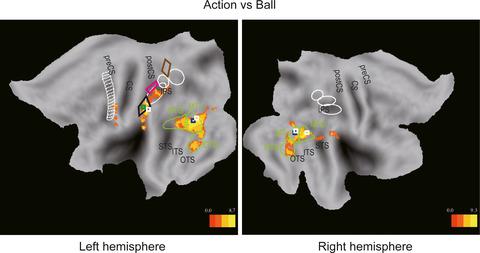当前位置:
X-MOL 学术
›
Eur. J. Neurosci.
›
论文详情
Our official English website, www.x-mol.net, welcomes your
feedback! (Note: you will need to create a separate account there.)
A parietal region processing numerosity of observed actions: An FMRI study.
European Journal of Neuroscience ( IF 2.7 ) Pub Date : 2020-08-03 , DOI: 10.1111/ejn.14930 Hiromasa Sawamura 1, 2 , Burcu A Urgen 1, 3, 4, 5 , Daniele Corbo 1, 6 , Guy A Orban 1
European Journal of Neuroscience ( IF 2.7 ) Pub Date : 2020-08-03 , DOI: 10.1111/ejn.14930 Hiromasa Sawamura 1, 2 , Burcu A Urgen 1, 3, 4, 5 , Daniele Corbo 1, 6 , Guy A Orban 1
Affiliation

|
When observing others' behavior, it is important to perceive not only the identity of the observed actions (OAs), but also the number of times they were performed. Given the mounting evidence implicating posterior parietal cortex in action observation, and in particular that of manipulative actions, the aim of this study was to identify the parietal region, if any, that contributes to the processing of observed manipulative action (OMA) numerosity, using the functional magnetic resonance imaging technique. Twenty‐one right‐handed healthy volunteers performed two discrimination tasks while in the scanner, responding to video stimuli in which an actor performed manipulative actions on colored target balls that appeared four times consecutively. The subjects discriminated between two small numerosities of either OMAs (“Action” condition) or colors of balls (“Ball” condition). A significant difference between the “Action” and “Ball” conditions was observed in occipito‐temporal cortex and the putative human anterior intraparietal sulcus (phAIP) area as well as the third topographic map of numerosity‐selective neurons at the post‐central sulcus (NPC3) of the left parietal cortex. A further region of interest analysis of the group‐average data showed that at the single voxel level the latter area, more than any other parietal or occipito‐temporal numerosity map, favored numerosity of OAs. These results suggest that phAIP processes the identity of OMAs, while neighboring NPC3 likely processes the numerosity of the identified OAs.
中文翻译:

顶叶区域处理观察到的动作的数量:一项 FMRI 研究。
在观察他人的行为时,重要的是不仅要感知观察到的行为 (OA) 的身份,还要感知它们执行的次数。鉴于越来越多的证据表明后顶叶皮层涉及动作观察,特别是操纵动作,本研究的目的是确定有助于处理观察到的操纵动作 (OMA) 数量的顶叶区域,如果有的话,使用功能磁共振成像技术。21 名右撇子健康志愿者在扫描仪中执行了两项辨别任务,对视频刺激做出反应,在视频刺激中,一名演员对连续出现四次的彩色目标球进行操作。受试者区分 OMA(“动作”条件)或球颜色(“球”条件)的两个小数值。在枕颞皮质和推定的人类顶内前沟 (phAIP) 区域以及中央后沟的数量选择性神经元的第三个地形图上观察到“动作”和“球”条件之间的显着差异。 NPC3) 左侧顶叶皮层。对组平均数据的进一步感兴趣区域分析表明,在单个体素水平上,后一个区域比任何其他顶叶或枕颞数量图更倾向于 OA 数量。这些结果表明 phAIP 处理 OMA 的身份,而相邻的 NPC3 可能处理已识别 OA 的数量。在枕颞皮质和推定的人类顶内前沟 (phAIP) 区域以及中央后沟的数量选择性神经元的第三个地形图上观察到“动作”和“球”条件之间的显着差异。 NPC3) 左侧顶叶皮层。对组平均数据的进一步感兴趣区域分析表明,在单个体素水平上,后一个区域比任何其他顶叶或枕颞数量图更倾向于 OA 数量。这些结果表明 phAIP 处理 OMA 的身份,而相邻的 NPC3 可能处理已识别 OA 的数量。在枕颞皮质和推定的人类顶内前沟 (phAIP) 区域以及中央后沟的数量选择性神经元的第三个地形图上观察到“动作”和“球”条件之间的显着差异。 NPC3) 左侧顶叶皮层。对组平均数据的进一步感兴趣区域分析表明,在单个体素水平上,后一个区域比任何其他顶叶或枕颞数量图更倾向于 OA 数量。这些结果表明 phAIP 处理 OMA 的身份,而相邻的 NPC3 可能处理已识别 OA 的数量。
更新日期:2020-08-03
中文翻译:

顶叶区域处理观察到的动作的数量:一项 FMRI 研究。
在观察他人的行为时,重要的是不仅要感知观察到的行为 (OA) 的身份,还要感知它们执行的次数。鉴于越来越多的证据表明后顶叶皮层涉及动作观察,特别是操纵动作,本研究的目的是确定有助于处理观察到的操纵动作 (OMA) 数量的顶叶区域,如果有的话,使用功能磁共振成像技术。21 名右撇子健康志愿者在扫描仪中执行了两项辨别任务,对视频刺激做出反应,在视频刺激中,一名演员对连续出现四次的彩色目标球进行操作。受试者区分 OMA(“动作”条件)或球颜色(“球”条件)的两个小数值。在枕颞皮质和推定的人类顶内前沟 (phAIP) 区域以及中央后沟的数量选择性神经元的第三个地形图上观察到“动作”和“球”条件之间的显着差异。 NPC3) 左侧顶叶皮层。对组平均数据的进一步感兴趣区域分析表明,在单个体素水平上,后一个区域比任何其他顶叶或枕颞数量图更倾向于 OA 数量。这些结果表明 phAIP 处理 OMA 的身份,而相邻的 NPC3 可能处理已识别 OA 的数量。在枕颞皮质和推定的人类顶内前沟 (phAIP) 区域以及中央后沟的数量选择性神经元的第三个地形图上观察到“动作”和“球”条件之间的显着差异。 NPC3) 左侧顶叶皮层。对组平均数据的进一步感兴趣区域分析表明,在单个体素水平上,后一个区域比任何其他顶叶或枕颞数量图更倾向于 OA 数量。这些结果表明 phAIP 处理 OMA 的身份,而相邻的 NPC3 可能处理已识别 OA 的数量。在枕颞皮质和推定的人类顶内前沟 (phAIP) 区域以及中央后沟的数量选择性神经元的第三个地形图上观察到“动作”和“球”条件之间的显着差异。 NPC3) 左侧顶叶皮层。对组平均数据的进一步感兴趣区域分析表明,在单个体素水平上,后一个区域比任何其他顶叶或枕颞数量图更倾向于 OA 数量。这些结果表明 phAIP 处理 OMA 的身份,而相邻的 NPC3 可能处理已识别 OA 的数量。











































 京公网安备 11010802027423号
京公网安备 11010802027423号